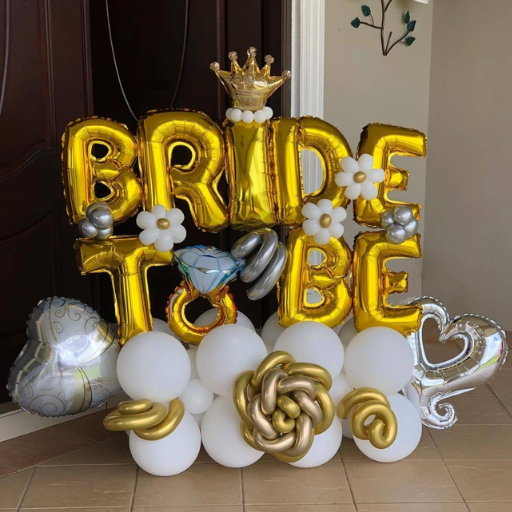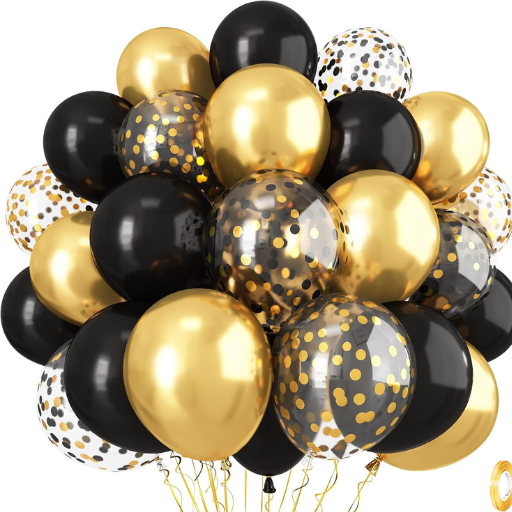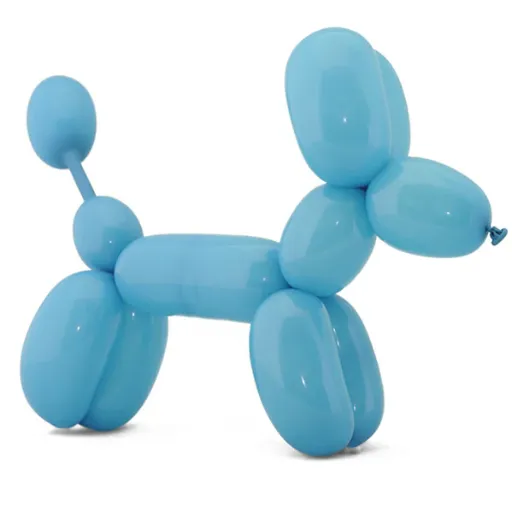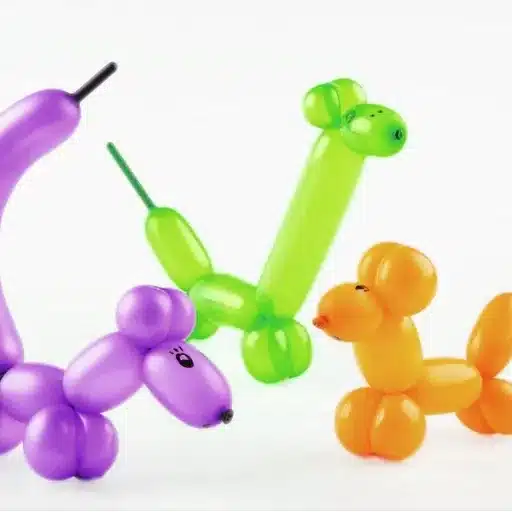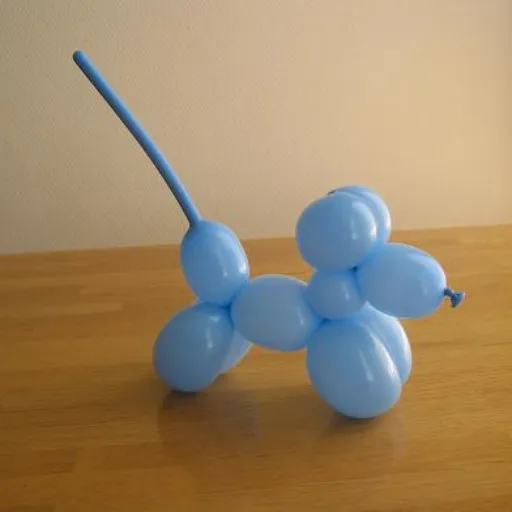Making balloon animals is an entertaining and imaginative talent that can cheer up children and adults, whether you are amusing at a party or just want to try something different. Twisting balloons may look like a tough task initially, but by way of a little practice and the proper methods, everybody can become a master at making cheerful forms and characters out of the colorful balloons. This guide for beginners will assist you in understanding the fundamentals of twisting the balloons, and it will make your new hobby much easier to start with. You will learn everything from selecting the right materials, and practicing simple but impressive designs, to do it all with us. By the time you finish, you will be all set to add your signature touch to this delightful, show-stopping art! Keep reading to find out how you can change the usual balloons into amazing creations.
The Basics of Balloon Animal Making

What Are Balloon Animals?
Balloon animals are bright and colorful sculptures made with twisting balloons. These are the balloons that are perfectly made for this purpose. Generally, they are made of elastic latex, which makes them strong and very flexible so they can be shaped into many different ways. Balloon animals are often the main attraction at kids’ birthday celebrations, street artists, and even business events. They come in different degrees of difficulty, from just a simple dog or sword to really complicated ones such as dinosaurs, flowers, or even a whole range of themed characters.
What is more, balloon twisting has been around since the late 1930s and has gone through stages until today when it is a widely accepted art, that is, “balloon modeling.” Worn out a bit, balloon industry data found that global sales in 2022 exceeded $600 million and an important part was from decorative and artistic uses like balloon twisting. Which points to the fact that balloon modeling is increasingly being recognized both as a source of amusement and as a form of creativity.
History of Balloon Twisting
The journey of balloon twisting starts from the very first rubber balloons which came into being in 1824 when Michael Faraday produced them for his experiments. However, it was not until the early 1900s that balloons found their way into the entertainment industry. A legend has it that the beginning of balloon twisting as an art was due to a Pennsylvania resident Herman J. Bonnert who, as early as the 1930s, was performing with balloons. In that era, balloon animals were not only made but also used live during the entertainment of the public mainly at fairs and parties.
Balloon twisting was resorted to by more people after the introduction of latex balloons in the late 1930s and the 1940s which were made mainly for this purpose. The 1950s and the 1960s saw the art of balloon twisting reaching a very high level of popularity as professional clowns and magicians used it to entertain people and thus they attracted larger audiences. Craft balloon twisting experiences continued to rise along with the emergence of children’s birthday parties and theme parks where balloon sculptures became one of the main amusement forms.
Benefits of Learning to Make Balloon Animals
Making balloon animals is an activity that offers lots of advantages to people of all ages. To start with, it is a great way to develop one’s creative skills and also dexterity as it pushes individuals to think in a 3D way and at the same time master the advanced twisting skills. For kids, the activity is a good way to develop their brain’s problem-solving part and also improve their hand-eye coordination. It has been noted that the practice of hands-on art like balloon-smithing has contributed up to 20% increase in fine motor skills of the participants.
Moreover, balloon twisting is a skill that can open up new career avenues. Based on a report from trends, searches for “balloon art services” and “balloon artist jobs” experienced a rise of 35% from 2021 onwards, thus the need for such skilled people is certainly on the rise. It is also an incredibly interactive activity; people who take part in balloon twisting workshops usually claim to have developed better cooperation skills and have made new friends.
Essential Materials and Tools Needed

Starting off with balloon twisting, the first three necessary items are a first-rate balloon pump, a professional-grade supply of twisting balloons, and a pair of sharp scissors. Furthermore, having a marker for making designs more vivid and a simple guide or a tutorial for learning different shapes would be a great support.
Types of Balloons for Animal Making
The balloon twisting activity is supported with different kinds of balloons, which may vary depending on the design, durability, and level of complexity. 260Q balloons are the most popular among all the balloon types for making animals. They, when inflated, are around 2 inches in diameter and 60 inches in length, yield a 260Q balloon’s Full State. The main reason for the popularity of these balloons is their combination of versatility and durability; you can easily twist them into different shapes, e.g., dogs, swords, flowers, etc.
Another option that is also popular is the 160Q balloon, which is a thinner version of the 260Q and has a diameter of 1 inch and a length of 60 inches. These balloons are generally used for giving special attention to small details like legs, or facial features in sculptures. To make big sculptures or if the sculptures are intricate, then it will be 350Q balloons that would be the perfect choice due to their size (3-inch diameter by 50-inch length); hence, they give extra strength and visibility to bigger characters.
The Importance of Using a Balloon Pump
Using a balloon pump is undoubtedly the most efficient and safest means of inflating balloons in a methodical way; mainly for complicated balloon twisting or large decorations. A balloon pump not only saves you from the rigor of manual inflating but also helps in a multipost scenario where a lot of balloons are involved; it is both physically taxing and time-consuming if done manually.
As per the latest scientific research and statistics, the use of balloon pumps can result in the time taken for inflating being reduced by 70% at the maximum as compared to manual methods. Hand-operated portable pumps are a flexible option for mini-projects while the electric balloon pump is an absolute grand choice in professional use during events. Such pumps are capable of inflating hundreds of balloons in an hour. The majority of the contemporary electric pumps are endowed with sophisticated features, such as airflow and pressure settings that can be modified, thus exercising control over the inflation process and minimizing the occurrence of over-inflation and bursting.
Step-by-Step Guide to Making Simple Balloon Animals

If you’re planning to pump a great number of balloons, I would suggest an electric balloon pump for the sake of efficiency. It is time-saving, gives you precision with the adjustable settings, and also decreases the risk of under-inflation.
How to Make Adorable Balloon Swan
Making a balloon swan is a fun method to practice your balloon-twisting tricks. Although this design is a notch higher than the classic balloon dog, it is still acceptable for amateurs as long as the instructions are strictly followed. According to a recent inquiry, novice balloon artists can generally finish a basic balloon swan in approximately 10-15 minutes with the right support.
Step-by-Step Directions:
Inflate the Balloon
Pump the balloon and allow around 5-6 inches to remain uninflated at the twisted end for the purpose of twisting. Properly sealing the balloon shuts off the air inside it.
Generate the Swan Neck
Start by twisting a long segment around 6-8 inches from the knot end of the balloon. This will give the swan its long and graceful neck.
Make the Head
Fold the end of the balloon at the neck to make a tiny loop. Then twist the loop tightly enough so that it does not break and this is the swan’s head and beak. Make sure the twists are strong but not too tight to cause bursting of the balloon.
Design the Body
Now take the longest part of the balloon and dip it into a rounded shape like an oval, leaving one side open to show the wings that are fluttered. Then twist where the neck is to hold the swan’s body.
Modify and Complete
Give the wings and neck a soft and light touch to show off the swan’s beauty. If you want, use a pen to draw tiny eye features on the head.
Tips and Tricks for Beginners

Common Mistakes to Avoid
Overinflating the Balloon: One of the most frequent missteps is the overinflation of the balloon which consequently raises the likelihood of the balloon bursting during the twisting. To prevent this from happening, ensure to keep about 1-2 inches of the balloon uninflated at the end, which will provide flexibility during the twisting operation.
Using Poor-Quality Balloons: There is a wide range of quality among balloons. The ones of lower quality are more susceptible to bursting or tearing. However, based on the recent community polls and reviews, trusted brands such as Qualatex and Betallatex have always been at the top of the list of balloon artists thanks to their durability and elasticity.
Skipping Proper Twisting Techniques: One of the most common mistakes by beginners is that they twist balloons too fast, and they do not pinch to keep the air in replacement resulting in the formation of unstable structures. Nevertheless, some research shows that practicing slow and deliberate twisting not only enhances stability but also reduces the amount of stress on the balloon.
Not Preparing for Environmental Factors: The performance of balloons can be affected by temperature and humidity. An example is that heat can make balloons expand and burst, while cold air makes the balloon to lose its elasticity. The professionals suggest that balloons should always be kept in a cool dry place and that the designs should be adjusted according to the conditions of the location where the balloons are kept.
How to Fix Popped Balloons
Patch Small Tears or Holes
In case the balloon has a small tear and has not completely burst yet, you can securely patch it temporarily. Take transparent tape, such as clear adhesive or cellophane tape, and use it to close the tear. A proper cleaning of the area around the tear should be done first to promote better stickiness. Although this method may not provide the full functionality, it surely can prolong the life of the balloon kept for display.
Prevent Weak Spots
In order to avoid the popping of the balloons to a great extent, one of the steps to be taken is to not overinflate them. It is suggested to inflate the balloons up to approximately 90% of their capacity in order to reduce the pressure on the material. Besides, keeping the balloons away from sharp objects, heat sources, and direct sunlight will also help since latex and foil balloons are affected negatively in such conditions by losing their quality faster.
Creative Alternatives for Popped Balloons
Balloons that have burst do not have to be thrown away. They can be chopped into small pieces and then transformed into confetti and other decorative materials. As for the latex parts, they can also be used for DIY crafts such as jewelry, small décor items, or filling clear ornaments.
Safety and Disposal
Research evidence suggests that proper disposal of balloon pieces and fragments is of utmost importance to prevent choking accidents, especially for young children and pets. Thus, one should always pick and throw away popped balloon parts in trash bags that are secure and covered. Moreover, it has been reported that non-biodegradable balloon litter can also cause environmental damage, so the choice of biodegradable balloons and proper disposal methods can help reduce the environmental impact.
Additional Resources
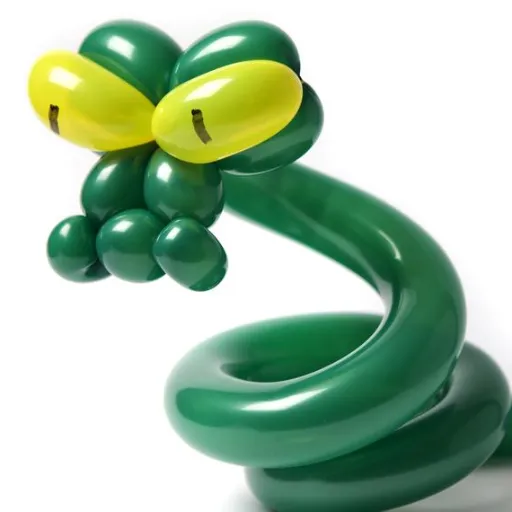
Recommended Books on Balloon Twisting
“Balloonology” by Jeremy Telford
This guide is very nice for every beginner as it provides step-wise to work and also gives more than 32 designs to choose from. Jeremy Telford a very experienced balloon artist edifies very difficult twists and folds to the simplest form so that anyone can create animals, hats, etc. Not just the text but the visuals also come as a great help in learning the basics.
“The DIY Balloon Bible For All Seasons” by Sandi Masori
This book is all about seasons, so it is a tremendous source of inspiring creative balloon decorations. It not only gives a very detailed guide of making balloons for different holidays, parties, and special occasions but also assists the user in crafting one-of-a-kind designs that are theme-based.
“Twist and Shout! The Professional Balloon Entertainer’s Handbook” by Sheree Brown
This guide is for professional balloon twisters only; the author tells about the business side of balloon twisting and that too very deeply. Besides, it contains talking about advanced twisting techniques, entertaining tips, and giving rise to a successful balloon entertainment business.
“Balloon Sculpting” by Bruce Fife
Dubbed as a classic book in balloon twisting circles, the book provides detailed procedures for a wide variety of figures. This book is very much suitable for middle-level skilled persons who aspire to advance their skills and learn new animal and object designs.
“Balloon Art” by Steven Jones
The book introduces creative thinking married with an artistic touch. In addition, detailed diagrams will assist the reader, who wants to go beyond the ordinary, in balloon art.
Reference Sources
-
The Spruce Crafts
Article: 5 Balloon Animals You Need to Know for Parties
This source discusses simple balloon animals suitable for parties, emphasizing their appeal to children and their ease of creation. -
Twisty Art
Article: A Guide to Starting and Growing Your Balloon Twisting Business
This guide highlights key markets for balloon twisting, including children’s parties, and mentions the popularity of simple balloon animals.
Frequently Asked Questions (FAQs)
How to make a dog balloon step by step?
To create a balloon dog step by step, first, inflate a long balloon and keep some air in the end part. Do the first twist to make the dog’s nose, then, twist two more times for the ears. After that, make a loop twist for the body and use more twists for the legs and tail. This step by step guide is very easy for the novices.
Is it possible to learn balloon twisting by watching video tutorials?
Absolutely, video tutorials are a great way to learn balloon twisting. They assist visually and show the steps like making a basic twist, lock twist, and even balloon flowers or a giraffe. Many of the tutorials are aimed at beginners.
What is the main method to create balloon animals?
Ultimately, the method to creating balloon animals is uninflated balloon, securing it with your grip, and applying various twists to form shapes. Knowing the basic twist, fold twist, and pinch twist will allow you to make a variety of balloon animals with ease.
What is the proper way to inflate a balloon?
The proper way to inflate a balloon is to use a pump for balloons to get the best results, making sure not to over-inflate. Leave a part of the balloon that is not inflated, so that twisting can be done. During the inflation, grip the balloon tightly at the neck and make sure that the air reaches the end without bursting.
What crafts can I do with a balloon?
The crafts that can be made with balloons include making balloon flowers, animals like swans and parrots, and making decorative balloon arches. All of these crafts require the same basic techniques and twists which makes them ideal for parties and events.
How to create two balloon sections for a giraffe?
To create a giraffe you need two balloon sections, first, inflate a long balloon and make the first twist for the neck. Then, create a second twist for the head. Use more twists to form the legs and body but be careful so that each segment is well-defined for a recognizable giraffe shape.


